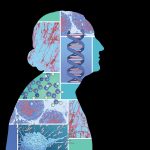Even for killer T cells—specialized immune cells—seeking and destroying cancer cells around the clock can be exhausting. In a new study, Professor Susan Kaech, first author Anna-Maria Globig, and colleagues discovered that the body’s sympathetic stress response (“fight-or-flight”) hormones can exhaust killer T cells in varying cancer types in mouse and human tissue samples—and that exhaustion can be inhibited with beta-blockers. Their discovery demonstrates the potential benefit of pairing beta-blockers with existing immunotherapies to improve cancer treatment by bolstering killer T cell function.
Discoveries
Rewiring tumor mitochondria enhances the immune system’s ability to recognize and fight cancer
Immunotherapy, which uses the body’s own immune system to fight cancer, is an effective treatment option, yet many patients do not respond to it. Thus, cancer researchers are seeking new ways to optimize immunotherapy so that it is more effective for more people. Now, Professors Susan Kaech and Gerald Shadel, co-first authors Kailash Chandra Mangalhara and Karthik Varanasi, and colleagues have found that manipulating an early step in energy production in mitochondria—the cell’s powerhouses—reduces melanoma tumor growth and enhances the immune response in mice. In the future, this manipulation of mitochondrial energy production may be leveraged to create new cancer therapeutics that are less harmful for mitochondria and cells.
Unleashing the power of AI to track animal behavior
Movement offers a window into how the brain operates and controls the body. Methods for tracking human and animal movement have come a long way, with current cutting-edge methods utilizing artificial intelligence to automatically track parts of the body as they move. However, training these models is still time-intensive and limited by the need for researchers to manually mark each body part hundreds to thousands of times. Associate Professor Eiman Azim, first author Daniel Butler, and colleagues have created GlowTrack, a noninvasive movement-tracking method that uses fluorescent dye markers to train artificial intelligence. GlowTrack is robust, time-efficient, and high-definition—capable of tracking a single digit on a mouse’s paw or hundreds of landmarks on a human hand.
“A new era in brain science”: Unveiling human brain cell atlas
Professor Joseph Ecker, Research Professor Margarita Behrens, co-first authors Jingtian Zhou and Wei Tian, and other Salk colleagues and global collaborators analyzed more than half a million brain cells from three human brains to assemble an atlas of hundreds of cell types that make up a human brain in unprecedented detail. The massive scientific collaboration is a part of the National Institutes of Health’s BRAIN Initiative, an effort launched in 2014 to describe the full plethora of cells in mammalian brains. More detailed work on a larger number of brains, Ecker says, will pave the way toward a better understanding of how certain brain cell types can malfunction in brain disorders and diseases.
Genetic architecture may be key to using peacekeeping immune cells to treat autoimmunity or fight cancer
Regulatory T cells are specialized immune cells that suppress the immune response and prevent the body from attacking its own cells. The behavior of these cells is influenced by chromatin architecture (the 3D shape of chromosomes) and which genes are accessible to proteins like Foxp3. Now, Professor Ye Zheng, Assistant Professor Jesse Dixon, co-first authors Dongsung Lee and Zhi Liu, and colleagues have discovered that Foxp3 is essential for creating the unique chromatin architecture of regulatory T cells and, in turn, promoting their immune suppressive function.
Repairing nerve cells after injury and in chronic disease
Each year in the United States there are more than 3 million cases of peripheral neuropathy, wherein nerves outside of the brain and spinal cord are damaged and cause pain and loss of feeling in the affected areas. Professor Samuel Pfaff, first author Lydia Daboussi, and colleagues have now uncovered a mechanism in mice for repairing damaged nerves during peripheral neuropathy. The findings have the potential to inspire novel therapeutics that bolster repair functions and heal peripheral neuropathy caused by diabetes, injury, genetically inherited disease, infection, and more.
How drugs can target the thick “scar tissue” of pancreatic cancer
Pancreatic cancer is one of the deadliest cancers—only about one in eight patients survives five years after diagnosis. Those dismal statistics are in part due to the thick, nearly impenetrable wall of fibrosis, or scar tissue, that surrounds most pancreatic tumors and makes it hard for drugs to access and destroy the cancer cells. Professor Ronald Evans, Senior Staff Scientists Michael Downes and Annette Atkins, first author Gaoyang Liang, and colleagues have now discovered how a class of anti-cancer drugs called HDAC inhibitors can help treat pancreatic cancer by modulating the activation of fibroblasts—the cells that make up that wall of scar tissue.
Assembling the first full epigenomic cell atlas of the mouse brain
In another NIH BRAIN Initiative collaboration of Salk colleagues and global collaborators, Professors Edward Callaway and Joseph Ecker and Research Professor Margarita Behrens worked together to publish four papers in a special feature in Nature with the goal of revolutionizing scientists’ understanding of the brain. The Salk team analyzed more than 2 million brain cells from mice to assemble the most complete mouse brain atlas ever. Altogether, the full 10-paper package details the thousands of cell types present in the mouse brain, how those cells connect, and which genes and regulatory programs are active in each cell.
Iron influences plant immunity and may promote resiliency against climate change
Plants and animals alike rely on iron for growth and regulation of microbiomes—collections of bacteria, fungi, and more that coexist in places like the human gut or the soil around a plant’s roots. Plants face a special challenge when acquiring iron, since the strategies plants use to increase iron availability alter the root microbiome and can inadvertently benefit harmful soil-dwelling bacteria. Professor Wolfgang Busch, first author Min Cao, and colleagues have discovered how plants manage iron deficiency without helping “bad” bacteria thrive—by eliminating IMA1, the molecular signal for iron deficiency in roots at risk of bacterial attack. Additionally, they found that this iron deficiency signaling pathway and the plant immune system are deeply intertwined.
Uncovering key brain pathway mediating panic disorder symptoms
Overwhelming fear, sweaty palms, shortness of breath, rapid heart rate—these are the symptoms of a panic attack, which people with panic disorder have frequently and unexpectedly. Creating a map of the regions, neurons, and connections in the brain that mediate these panic attacks can provide guidance for developing more effective panic disorder therapeutics. Now, Associate Professor Sung Han, co-first authors Sukjae Kang and Jong-Hyun Kim, and colleagues have begun to construct that map by discovering a brain circuit that mediates panic disorder. This circuit consists of specialized neurons that send and receive a neuropeptide—a small protein that sends messages throughout the brain—called PACAP. What’s more, they determined that PACAP and the neurons that produce its receptor are possible druggable targets for new panic disorder treatments.
Featured Stories
 Interaction + Infrastructure = Innovations in Healthy AgingSalk formula recalculates aging research, shifting focus to overall resilience and health span.
Interaction + Infrastructure = Innovations in Healthy AgingSalk formula recalculates aging research, shifting focus to overall resilience and health span. Professor Jan Karlseder named Salk’s Chief Science OfficerOn February 1, Jan Karlseder started as Salk’s new senior vice president and chief science officer (CSO).
Professor Jan Karlseder named Salk’s Chief Science OfficerOn February 1, Jan Karlseder started as Salk’s new senior vice president and chief science officer (CSO).  Salk mourns the loss of Nobel Laureate Roger GuilleminThe Institute remembers the “father of neuroendocrinology” for his many contributions to science and friendship to all.
Salk mourns the loss of Nobel Laureate Roger GuilleminThe Institute remembers the “father of neuroendocrinology” for his many contributions to science and friendship to all. Daniel Hollern–Turning a cancer diagnosis into a career in basic researchAssistant Professor Daniel Hollern pivoted his career trajectory after a family member’s life-changing diagnosis pushed his already-curious mind off a cliff of questions—starting with, “What can I do to help him?”
Daniel Hollern–Turning a cancer diagnosis into a career in basic researchAssistant Professor Daniel Hollern pivoted his career trajectory after a family member’s life-changing diagnosis pushed his already-curious mind off a cliff of questions—starting with, “What can I do to help him?” Jerry Sheehan–Collaborating shoulder to shoulder with scientistsWhen you think about a person who heads an information technology department, you might not envision them working shoulder to shoulder with research scientists. But that’s exactly the approach Jerry Sheehan is taking as Salk’s new chief information officer (CIO).
Jerry Sheehan–Collaborating shoulder to shoulder with scientistsWhen you think about a person who heads an information technology department, you might not envision them working shoulder to shoulder with research scientists. But that’s exactly the approach Jerry Sheehan is taking as Salk’s new chief information officer (CIO). Laura Mainz–Taking control after a cancer diagnosisLaura Mainz grew up in a tiny village in midwestern Germany, with just as many cows as people. But the sweeping landscape speckled with farms never swayed her toward plant biology—instead, her interest in the human body grew.
Laura Mainz–Taking control after a cancer diagnosisLaura Mainz grew up in a tiny village in midwestern Germany, with just as many cows as people. But the sweeping landscape speckled with farms never swayed her toward plant biology—instead, her interest in the human body grew. Black Association affinity group cultivates welcoming environmentThe Black Association at Salk (BAS) was one of the first affinity groups formed at Salk in 2020. Since that time, it has established itself as a welcoming space and go-to for resources for all Black Salk community members.
Black Association affinity group cultivates welcoming environmentThe Black Association at Salk (BAS) was one of the first affinity groups formed at Salk in 2020. Since that time, it has established itself as a welcoming space and go-to for resources for all Black Salk community members.
















































